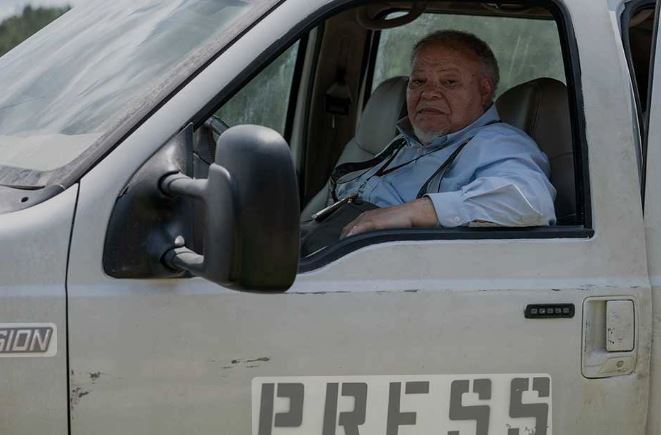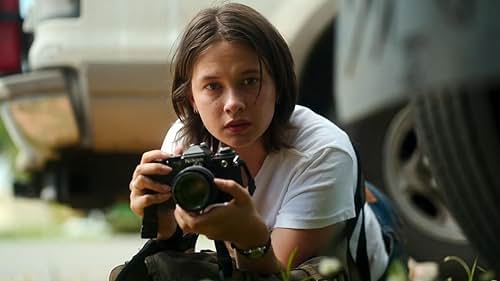At the start of Alex Garland’s Civil War, we see a suited man in profile (Nick Offerman) preparing a speech, whom we quickly infer to be the president of the United States. The phrases he’s trying out reek of exaggeration, as he’s talking about how “people” have said that a particular military victory is “the greatest in the history of mankind.” So this is a stand-in for the always-exaggerating Donald Trump, right? But wait, we also quickly learn that this man is a representation of the status quo fending off an insurrection by a segment of the American population who feels hard done by the government. So this is a stand-in for Joe Biden, right?
Never knowing who is the villain in Civil War embodies the constant fruitless recalibration of our sympathies that is Garland’s movie in a nutshell. Garland wanted to make a harrowing cautionary tale about the dangerous road a divided America has gone down, and could go down again depending on the outcome of November’s election – or possibly regardless of what the outcome is. He did not want to make a movie that demonised either progressives or conservatives. So he has purposely put different coloured faces in roles we would not automatically assume would align with the interests of their racial identity, and otherwise scrambled any political assumptions regarding his characters. The fact that the secessionist movement threatening that unnamed president is headed by the states of Texas and California – the ultimate red state and the ultimate blue state – is a tip-off that Garland wants to chill us and haunt us, irrespective of our political valances.
How better to play down the middle, then, to have the four main characters we follow be journalists and war photographers, whose very credo is to report on what they see without partisan bias. In some unspecified not-too-distant future, there are only a few pockets of America that are not some sort of war zone patrolled by police in riot gear or mercenaries carrying machine guns. We don’t learn the exact nature of the beef that caused any number of insurrections in the United States – in addition to the so-called Western Front, there is also a group coming north toward Washington D.C. from Florida – but we do know that it is widespread enough to engulf even those who wish to just stay out of it and quietly wait it out.
Our four journalists regularly throw themselves into the fray, eager to capture that perfect shot encapsulating the conflagration, the type that is usually only available on foreign soil. The first of those is Lee Smith (Kirsten Dunst), a celebrated war photographer who is a true believer in her non-interventionist philosophy, but also possibly questioning a career’s worth of disinterested involvement with death and mayhem. Her professional ally is Joel (Wagner Moura), a Reuters journalist who plans to join Lee on a suicidal trip beyond the front line of Charlottesville, North Carolina and into Washington D.C. proper, to photograph and interview the president before he is inevitably overthrown.
At one particular protest, she meets and saves a would-be war photographer in her 20s from a detonated explosive. Recognising her hero, Jessie Cullen (Cailee Spaeny) wangles her way into joining the road trip through a veritable minefield of unfriendly combatants, some of whom shoot journalists on sight. The final bit of potential target practice is Sammy (Stephen McKinley Henderson), who can’t give up his beat despite old age and poor physical condition, who also hitches a ride with Lee and Joel even though he works for the competition. The fact that he’s Lee’s mentor certainly helps.
By setting the film amidst a conflict that has been going on for months if not years, closer to its conclusion than its beginning, Garland spares us needing to spend a lot of time on learning how we got to this point and the specific points of disagreement between the sitting government and those who seek to overthrow it. This allows him ample time for character work with our four main characters, a choice that pays massive dividends. Serving as writer as well, Garland has an excellent grasp on how to imply any number of unsaid things, which works both as a way of shaping the contours of the conflict and shaping the inner lives of these characters. We believe this motley bunch of daring journalists effortlessly due to the grace of Garland’s touch. And since they themselves operate as a microcosm of society’s demographics – two young, two old, two men, two women, two white people, two minorities – they themselves stand for America, even if they are trying to stand for nothing in pursuit of their work.
The decision not to take sides, which is almost an imperative for a movie trying to reach a wide popular audience, does potentially rob the film of some of its thematic depth. If the movie were purely progressive – and there are signs of this, though they can only be dog whistles – it might be able to delve into the actual issues that are dividing the states in the months leading up to the third straight presidential election featuring Donald Trump.
But it is a very small sacrifice in the grand scheme of things, far more a feature than a bug. Civil War could not exist in any other form than it does and have the same hope of creating genuine impact on those in the U.S. who will consider violence if their presidential candidate does not win this November. The conversation about the movie is already raging there.
Besides, Civil War works tremendously well just on the level of sheer spectacle. We have seen the United States bombed out and broken from any number of alien invasion or natural disaster movies, but rarely have we seen it torn apart by its own people, and there’s something specifically unsettling about this. Frequently this feels like a zombie movie where the zombies are people, and it has all the pleasures of that genre, perhaps even invigorating it since actual zombie movies don’t have the impact they once had. Garland also has a great notion of how to dramatise the screaming thunderous noise of military combat. Especially in the climactic scene, it’s as overwhelming as any other sensory assault this movie gives us, from sudden bomb blasts to the indiscriminate assassination of civilians and the opposition alike.
All the while the cameras of our characters are capturing what’s happening, simultaneously questioning the role of the war photographer and underscoring its importance. As with some other messages Garland is delivering here, the takeaway is not always 100% clear, and sometimes we just have to chew on it ourselves. But there’s no doubt this works as a grand and anxiety producing adventure through a plausible future, one fuelled by the year’s best soundtrack. It leaves a person riveted, enthralled, and shaken.
Civil War is currently playing in cinemas.



